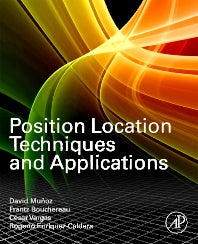Freshly Printed - allow 10 days lead
Couldn't load pickup availability
Position Location Techniques and Applications
The complete guide to position location techniques, models and algorithms, with applications to ‘hot’ R&D areas such as cognitive radio, sensor networks, wireless networks (UWB, WiFi, ZigBee, DVB networks) and dynamic network resource allocation.
David Munoz (Author), Frantz Bouchereau Lara (Author), Cesar Vargas (Author), Rogerio Enriquez-Caldera (Author)
9780123743534, Elsevier Science
Hardback, published 15 May 2009
296 pages
23.4 x 19 x 2.3 cm, 0.8 kg
"Overall, this book has a wider potential audience than communications engineers. Anyone involved in scanners, such as medical ultrasound instruments or robotic world-map builders for autonomous mobile vehicles, will have a possible interest in this book because the authors present their material in tutorial form, making it possible to benefit from the basic principles without being a communications specialist." --EN-Genius Network
This book is the definitive guide to the techniques and applications of position location, covering both terrestrial and satellite systems. It gives all the techniques, theoretical models, and algorithms that engineers need to improve their current location schemes and to develop future location algorithms and systems. Comprehensive coverage is given to system design trade-offs, complexity issues, and the design of efficient positioning algorithms to enable the creation of high-performance location positioning systems. Traditional methods are also reexamined in the context of the challenges posed by reconfigurable and multihop networks. Applications discussed include wireless networks (WiFi, ZigBee, UMTS, and DVB networks), cognitive radio, sensor networks and multihop networks. Features David Muñoz is Director and César Vargas is a member of the Center for Electronics and Telecommunications, Tecnológico de Monterrey, Mexico. Frantz Bouchereau is a senior communications software developer at The MathWorks Inc. in Natick, MA. Rogerio Enríquez-Caldera is at Instituto Nacional de Atrofisica, Optica y Electronica (INAOE), Puebla, Mexico.
The PL need and Historical Developments
PL requirements and Limitation
Terrestrial and Satellite Scenarios
Current and Potential Applications
AOA measurements
Nonparametric Methods for Estimation of AOA
Parametric Methods for Estimation of AOA
TOA and TDOA measurements
Range Estimation Based on Receive Signal strength (RSS)
Signal strength (RSS)
The Multilateration Problem
Geometrical multilateration
Statistical multilateration
Location estimation in multi hop scenarios
Performance assessment of location estimation systems
Single hop and relational scenarios
Multi Hop Scenarios
From Cellular to Reconfigurable Networks
Mobility in Wireless Networks
Towards the Cognitive Radio Paradigm for Position Location
Cellular Systems
Local / Indoor Network Scenario
Mesh Systems
Satellite Positioning
Structure of a System for Satellite Positioning
Fundamental Concepts Involved
Applications
Sources of Errors
Trends and Comparison
Large scale fading
Small scale fading
Compound fading models
Subject Areas: Signal processing [UYS], WAP [wireless technology TJKW], Radio technology [TJKR], Communications engineering / telecommunications [TJK], Geographical information systems [GIS & remote sensing RGW], Electricity, electromagnetism & magnetism [PHK]


